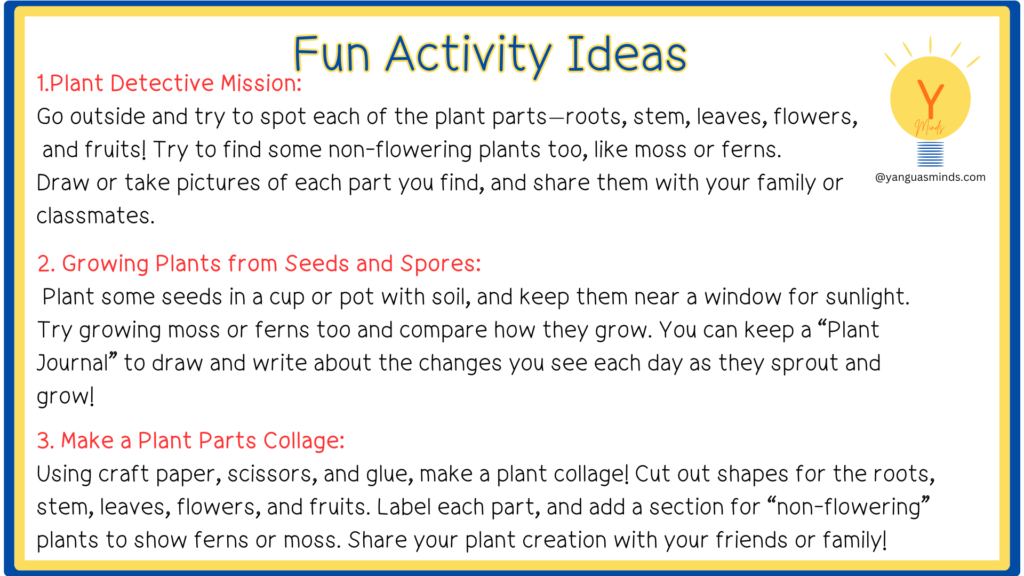Hello, Super Learners!
Today, we’re diving into the fascinating world of Plants! Did you know that plants are like living machines, each with parts that play important roles to help the plant grow, stay healthy, and even make more plants? Let’s explore the different parts of a plant and learn some cool facts along the way. We’ll also discover that not all plants are the same—some plants don’t even have flowers or fruits! Ready to become plant experts? Let’s get started!












Why Are Plants So Important?
Plants are essential for life on Earth. They give us oxygen to breathe, food to eat, and shelter for animals and insects. They also help keep the environment balanced by taking in carbon dioxide (the gas we breathe out) and releasing oxygen (the gas we need to breathe in). Imagine a world without plants—it would be very hard to survive!
The Basic Parts of a Plant
Plants are made up of several important parts, each with its own job. Just like we have eyes, hands, and a heart, plants have roots, stems, leaves, flowers, and sometimes fruits. Let’s take a closer look at each one!
1. Roots
-
Where to Find Them: Roots grow underground.
-
What They Do: Roots are like a plant’s “drinking straws.” They soak up water and minerals from the soil to nourish the plant. Roots also help anchor the plant to the ground, making sure it doesn’t fall over. Roots even store extra food for the plant, kind of like a pantry, so the plant can use it when it needs extra nutrients!
2. Stem
-
Where to Find It: The stem is the “trunk” of the plant that you see growing above the ground.
-
What It Does: The stem is like an elevator for water and nutrients! It moves these from the roots up to the leaves and other parts of the plant. The stem also helps the plant stand up straight and reach for sunlight. In some plants, like celery and cacti, the stem can even do photosynthesis, which means it helps make food for the plant!
3. Leaves
-
Where to Find Them: Leaves grow from the stem and branch out.
-
What They Do: Leaves are like the plant’s kitchen! They make food through a process called photosynthesis. The green color in leaves, called chlorophyll, captures sunlight and combines it with water and carbon dioxide from the air to create food for the plant. This process also makes oxygen, which we need to breathe. Leaves have tiny openings, called stomata, which help the plant “breathe” and release excess water.
4. Flower
-
Where to Find It: Flowers usually grow at the top of the stem or branch.
-
What It Does: Flowers are the plant’s “reproductive” part, meaning they help plants make seeds to grow new plants. Flowers have colorful petals and sweet smells to attract pollinators, like bees, butterflies, and birds. Pollinators help carry pollen from one flower to another, allowing seeds to form and grow into new plants!
5. Fruit
-
Where to Find It: Fruit often grows where the flower used to be after pollination.
-
What It Does: Fruits protect the seeds inside and help spread them. Animals (and people!) eat fruits, which helps scatter the seeds, giving them a chance to grow in new places. Fruits also protect the seeds until they’re ready to sprout into new plants.
Do All Plants Have Flowers and Fruits?
Not all plants have flowers or produce fruits! Plants are grouped into two main types based on how they reproduce:
-
Flowering Plants: These are the plants we see with colorful blooms and, eventually, fruits. Examples include roses, sunflowers, and apple trees. These plants produce seeds after their flowers are pollinated. The seeds inside the fruits can grow into new plants.
-
Non-Flowering Plants: Some plants don’t have flowers or fruits at all! Instead, they produce spores to grow new plants. Ferns and mosses are examples of non-flowering plants. Spores are tiny, dust-like particles that spread through the air or water to grow new plants. You might find ferns growing in shaded forest areas, often covered in tiny spots underneath their leaves—those are their spores!
Why Don’t All Plants Have Flowers?
Plants have adapted in amazing ways to reproduce and survive in different environments. Non-flowering plants like ferns and mosses evolved to reproduce with spores rather than seeds. Since they don’t need flowers to attract pollinators, they’ve developed other methods to ensure their spores spread far and wide. Flowers require a lot of energy to grow and maintain, so non-flowering plants save energy by not producing flowers, relying on wind, water, or gravity to spread their spores.

Congratulations, Super Learners! Now you know the different parts of a plant and the important jobs they each have. Remember, plants are our friends—they give us food, oxygen, and beauty all around us. Keep exploring, and let’s always take good care of the amazing plants in our world!
